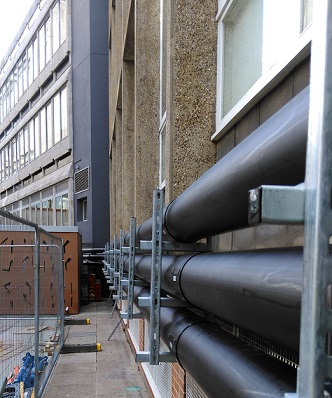Renewable Cooling
District Cooling Networks
Cooling and air conditioning accounts for an increasing proportion of energy use as modern glazed buildings absorb large amounts of solar energy and temperatures rise to unacceptable levels: up to 10% of all UK electricity is used to provide cooling.
The standard solution for cooling is very inefficient
The standard solution of mounting chillers of the roof and "wasting" heat energy into hot air is very inefficient: it requires a large consumption of electricity to force heat into hot air – against the natural flow of nature, which is for heat to move from warmer bodies to colder bodies.
The elegant alternative is to allow heat to escape to cold groundwater
There is a more natural alternative route of allowing heat to escape from buildings by heat exchange with cold groundwater.
Most towns and cities have access to aquifers because the original settlers needed access to fresh water. Open loop boreholes can provide access to aquifers. Closed loop boreholes can also provide heat exchange capacity with ground which is much colder than the the air on days when cooling is needed. By circulating warm water from the building down to the cold ground heat can be purged naturally from buildings. If this "free cooling" does not provide sufficient capacity, then a heat pump can be used to accelerate the process of transferring heat from the building down to the ground.
District Cooling Networks
Although cooling by heat exchange with cold groundwater is very efficient to run – cheap on electricity and with zero on-site carbon emissions – there is an infrastructure cost of providing the boreholes to allow this to work. It makes sense to share the capital cost of drilling boreholes with adjacent buildings and establishing a common groundwater network between a number of buildings to provide a District Cooling Network.
Most towns are also based around rivers, which is a further resource that can be used to purge heat from a District Cooling Network. Many of the world's largest cities are built beside the sea and have an infinite capacity for heat exchange with the sea.
There is a major advantage of establishing a District Cooling Network based on an ambient ground temperature circuit, with heat pumps in each building to provide low carbon cooling: the same mechanism can be run in reverse in winter to provide combustion-free heating.
Advantages of a District Cooling System
There are many advantages of a district cooling system based on a communal ground array with water source cooling pumps in each building:
- heat exchange with cold groundwater is much less expensive than using roof mounted chillers which struggle to waste heat into hot air
- district cooling with groundwater is discreet and silent compared to using air exchange chillers
- using a communal ground array allows the capital cost to be shared across a district
- the radically lower electricity consumption releases lower greenhouse gases from power stations
- electric coolinging allows the owner to earn income from Demand Side Response
- annual maintenance costs are much lower than with conventional air conditioning systems
- heat transfer is a combustion-free system and therefore improves air quality in the local district
- the life of the installed equipment can be twice as long as for air chiller systems
- the life of the installed groundwater array can be as long as 100 years
- the same system can be used in reverse for efficient space heating in winter.
- and the Renewable Heat Incentive is available to owners using ground source heating.
Disadvantages of a District Cooling System
There are few disadvantages of a district cooling system based on a communal ground array with water source cooling pumps in each building. However:
- there is a higher capital cost of installation compared to installing chillers on the roof of each building, (but the capital cost will be less than the cost of installing chillers for cooling and a separate boiler system for heating)
- there may be legal issues of reaching agreement to install a district cooling system if the benefits are to be shared between different legal entities.


